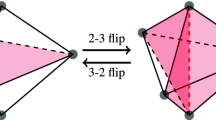Abstract
We present a mesh optimization algorithm for adaptively improving the finite element interpolation of a function of interest. The algorithm minimizes an objective function by swapping edges and moving nodes. Numerical experiments are performed on model problems. The results illustrate that the mesh optimization algorithm can reduce the W 1,∞ semi-norm of the interpolation error. For these examples, the L 2, L ∞, and H 1 norms decreased also.















Similar content being viewed by others
Notes
In the numerical experiments, this search is implemented with a simple loop through the elements of the background mesh.
References
Agouzal A, Lipnikov K, Vassilevski Y (1999) Adaptive generation of quasi-optimal tetrahedral meshes. East West J Numer Math 7(4):223–244
Alauzet F, Frey P (2003) Estimation d’erreur géométrique et métriques anisotropes pour l’adaptation de maillage. Partie II: exemples d’applications. Technical Report 4789, INRIA
Apel T, Berzins M, Jimack P, Kunert G, Plaks A, Tsukerman I, Walkley M (2000) Mesh shape and anisotropic elements: Theory and practice. In: The mathematics of finite elements and applications, vol 10. Elsevier, Amsterdam, pp 367–376
Babuška I, Aziz AK (1976) On the angle condition in the finite element method. SIAM J Numer Anal 13:214–226
BAMG, Bidimensional anisotropic mesh generator. http://pauillac.inria.fr/cdrom/www/bamg/eng.htm
Bank R, Smith R (1997) Mesh smoothing using a posteriori error estimates. SIAM J Numer Anal 34:979–997
Bank R, Xu J (2003) Asymptotically exact a posteriori error estimators, part II: general unstructured grids. SIAM J Numer Anal 41:2313–2332
Buscaglia G, Dari E (1997) Anisotropic mesh optimization and its application in adaptivity. Int J Numer Meth Eng 40:4119–4136
Cao W (2005) On the error of linear interpolation and the orientation, aspect ratio, and internal angles of a triangle. SIAM J Numer Anal 43:19–40
Chen L (2004) Mesh smoothing schemes based on optimal Delaunay triangulations. In: Proceedings of 13th international meshing roundtable
Chen L, Sun P, Xu J (2007) Optimal anisotropic meshes for minimizing interpolation errors in L p-norm. Math Comp 76:179–204
Courty F, Leservoisier D, George PL, Dervieux A (2006) Continuous metric and mesh adaptation. Appl Numer Math 56:117–145
D’Azevedo E, Simpson R (1989) On optimal interpolation triangle incidences. SIAM J Sci Comput 10:1063–1075
Dompierre J, Vallet MG, Bourgault Y, Fortin M, Habashi W (2002) Anisotropic mesh adaptation: towards user-independent, mesh-independent and solver independent CFD. Part III: unstructured meshes. Int J Numer Meth Fluids 39:675–702
Felippa C (1976) Optimization of finite element grids by direct energy search. Appl Math Model 1:93–96
Field D (2000) Qualitative measures for initial meshes. Int J Numer Meth Eng 47:887–906
Fletcher R (1987) Practical methods of optimization. Wiley, New York
Frey P, Alauzet F (2005) Anisotropic mesh adaptation for CFD computations. Comput Methods Appl Mech Eng 194:5068–5082
Hager W, Zhang H (2006) Algorithm 851: CG_DESCENT, a conjugate gradient method with guaranteed descent. ACM Trans Math Softw 32:113–137
Hetmaniuk U, Knupp P (2008) Mesh optimization algorithms to decrease the linear interpolation error. SAND Report
Huang W (2006) Mathematical principles of anisotropic mesh adaptation. Commun Comput Phys 1:276–310
Jimack P, Mahmood R, Walkley M, Berzins M (2002) A multilevel approach for obtaining locally optimal finite element meshes. Adv Eng Softw 33:403–415
Lagüe JF (2006) Optimisation de maillage basée sur une erreur locale d’interpolation. PhD thesis, Université de Paris VI
Mesquite, Mesh quality improvement toolkit. See http://www.cs.sandia.gov/optimization/knupp/Mesquite.html
Remacle JF, Li X, Shephard M, Flaherty J (2005) Anisotropic adaptive simulation of transient flows using discontinuous Galerkin methods. Int J Numer Meth Eng 62:899–923
Rippa S (1992) Long and thin triangles can be good for linear interpolation. SIAM J Numer Anal 29:257–270
Roe P, Nishikawa H (2002) Adaptive grid generation by minimizing residuals. Int J Numer Meth Fluids 40:121–136
Tourigny Y, Hülsemann F (1998) A new moving mesh algorithm for the finite element solution of variational problems. SIAM J Numer Anal 35:1416–1438
Tourigny Y (2005) The optimisation of the mesh in first-order systems least-squares methods. J Sci Comput 24:219–245
Vallet MG, Manole C, Dompierre J, Dufour S, Guibault F (2007) Numerical comparison of some Hessian recovery techniques. Int J Numer Meth Eng 72:987–1007
Walkley M, Jimack P, Berzins M (2002) Anisotropic adaptivity for the finite element solutions of three-dimensional convection-dominated problems. Int J Numer Meth Fluids 40:551–559
Author information
Authors and Affiliations
Corresponding author
Additional information
Sandia is a multiprogram laboratory operated by Sandia Corporation, a Lockheed Martin Company, for the United States Department of Energy under Contract DE-AC04-94AL85000.
Rights and permissions
About this article
Cite this article
Hetmaniuk, U., Knupp, P. A mesh optimization algorithm to decrease the maximum interpolation error of linear triangular finite elements. Engineering with Computers 27, 3–15 (2011). https://doi.org/10.1007/s00366-010-0176-8
Received:
Accepted:
Published:
Issue Date:
DOI: https://doi.org/10.1007/s00366-010-0176-8



